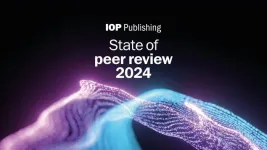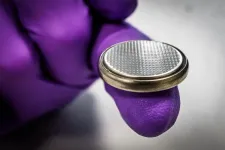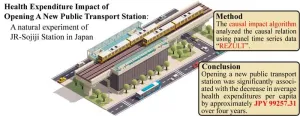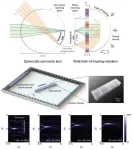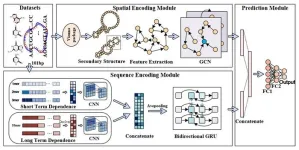WASP-193b, a giant planet with a density similar to that of cotton candy
This exoplanet is larger but seven times less massive than Jupiter and is the second least dense planet discovered to date
2024-05-14
(Press-News.org)
An international team led by researchers from the EXOTIC Laboratory of the University of Liège, in collaboration with MIT and the Astrophysics Institute in Andalusia, has just discovered WASP-193b, an extraordinarily low-density giant planet orbiting a distant Sun-like star.
This new planet, located 1,200 light-years from Earth, is 50% larger than Jupiter but seven times less massive, giving it an extremely low density comparable to that of cotton candy. "WASP-193b is the second least dense planet discovered to date, after Kepler-51d, which is much smaller," explains Khalid Barkaoui, a Postdcotral Researcher at ULiège's EXOTIC Laboratory and first author of the article published in Nature Astronomy. Its extremely low density makes it a real anomaly among the more than five thousand exoplanets discovered to date. This extremely-low-density cannot be reproduced by standard models of irradiated gas giants, even under the unrealistic assumption of a coreless structure.”
The new planet was initially spotted by the Wide Angle Search for Planets (WASP), an international collaboration of academic institutions that together operated two robotic observatories, one in the northern hemisphere and the other in the south. Each observatory used an array of wide-angle cameras to measure the brightness of thousands of individual stars across the entire sky. In data taken between 2006 and 2008, and again from 2011 to 2012, the WASP-South observatory detected periodic transits, or dips in light, from the star WASP-193. Astronomers determined that the star’s periodic dips in brightness were consistent with a planet passing in front of the star every 6.25 days. The scientists measured the amount of light the planet blocked with each transit, which gave them an estimate of the planet’s size.
The team used then the TRAPPIST-South and SPECULOOS-South observatories - directed by Michaël Gillon, FNRS Research Director and astrophysicist at ULiège - located in the Atacama Desert in Chile to measure the planetary signal in different wavelengths and to validate the planetary nature of the eclipsing object. Finally, they also used spectroscopic observations collected by the HARPS and CORALIE spectrographs – also located in Chile (ESO)- to measure the mass of the planet. To their great surprise, the accumulated measurements revealed an extremely low density for the planet. Its mass and its size, they calculated, were about 0.14 and 1.5 that of Jupiter, respectively. The resulting density came out to about 0.059 grams per cubic centimeter. Jupiter’s density, in contrast, is about 1.33 grams per cubic centimeter; and Earth is a more substantial 5.51 grams per cubic centimeter. One of the materials closest in density to the new, puffy planet, is cotton candy, which has a density of about 0.05 grams per cubic centimeter.
“The planet is so light that it’s difficult to think of an analogous, solid-state material,” says Julien de Wit, professor at Massachusetts Institute of Technology (MIT) and co-author. “The reason why it’s close to cotton candy is because both are pretty much air. The planet is basically super fluffy.”
The researchers suspect that the new planet is made mostly from hydrogen and helium, like most other gas giants in the galaxy. For WASP-193b, these gases likely form a hugely inflated atmosphere that extends tens of thousands of kilometers farther than Jupiter’s own atmosphere. Exactly how a planet can inflate so much is a question that no existing theory of planetary formation can yet answer. It certainly requires a significant deposit of energy deep into the planet’s interior, but the details of the mechanism are not yet understood. “We don’t know where to put this planet in all the formation theories we have right now, because it’s an outlier of all of them. We cannot explain how this planet was formed. Looking more closely at its atmosphere will allow us to constrain an evolutionary path of this planet, adds Francisco Pozuelos, astronomer at the Instituto de Astrofisica de Andalucia (IAA-CSIC, Granada, Spain)."
“WASP-193b is a cosmic mystery. Solving it will require some more observational and theoretical work, notably to measure its atmospheric properties with the JWST space telescope and to confront them to different theoretical mechanisms that possibly result in such an extreme inflation”, concludes Khalid Barkaoui.
END
ELSE PRESS RELEASES FROM THIS DATE:
2024-05-14
A new global study from IOP Publishing (IOPP) has found that certain peer review communities continue to feel overburdened by reviewer requests, while others remain underrepresented.
The survey, which generated over 3,000 responses from peer reviewers from across the globe, revealed regional and career-stage disparities:
30% of reviewers from high-income countries indicated that they receive too many peer review requests, compared with just 10% from low and middle-income countries*
Just 6% of respondents from China and 7% from India indicated that they ...
2024-05-14
A battery made from zinc and lignin that can be used over 8000 times. This has been developed by researchers at Linköping University, Sweden, with a vision to provide a cheap and sustainable battery solution for countries where access to electricity is limited. The study has been published in the journal Energy & Environmental Materials.
“Solar panels have become relatively inexpensive, and many people in low-income countries have adopted them. However, near the equator, the sun sets at around 6 PM, leaving households and businesses without electricity. The hope is that ...
2024-05-14
The declining population in Osaka is related to an aging society that is driving up health expenditures. Dr. Haruka Kato, a junior associate professor at Osaka Metropolitan University, teamed up with the Future Co-creation Laboratory at Japan System Techniques Co., Ltd. to conduct natural experiments on how a new train station might impact healthcare expenditures.
JR-Sojiji Station opened in March 2018 in a suburban city on the West Japan Railway line connecting Osaka and Kyoto. The researchers used a causal impact algorithm to analyze the medical expenditure data gathered from the time series medical ...
2024-05-14
Compared to Black and Asian people, white and Hispanic people with Alzheimer’s disease and related dementias were most likely to be diagnosed with symptoms like depression and agitation, according to a new study from the USC Schaeffer Center for Health Policy & Economics.
White and Hispanic people with these diagnoses were also most likely to be prescribed central nervous system (CNS) active drugs, including antidepressants, antipsychotics and anticonvulsants. Yet, these drugs have been associated with higher risk of falls, cardiovascular events, hospitalization and death, according to the study published today in the Journal of Alzheimer’s ...
2024-05-14
Junsuk Rho from the Department of Mechanical Engineering, the Department of Chemical Engineering, and the Department of Electrical Engineering, Dr. Dongwoo Lee from the Department of Mechanical Engineering, and Beomseok Oh, a PhD student, from the Department of Chemical Engineering at Pohang University of Science and Technology (POSTECH) have achieved a breakthrough in surpassing the limitations of traditional acoustic metalenses. They have successfully developed the first wide field-of-hearing metalens. This research has been recently published in the international journal, Nature Communications.
Sound ...
2024-05-14
Since the inception of microcomb, whose generation relies on Kerr nonlinearity in microresonator, the coherent soliton state has attracted intense researches. Although the operation of sub-comb outputs is straightforward, as noncoherent comb state, it was often overlooked in previous techniques. With graphene sensitization, this sub-comb heterodyne sensing device exhibits an exceptional response to gas molecular adsorption, achieving detect limits of 1.2 ppb for H2S gas and 1.4 ppb for SO2 gas, respectively. In summary, our research synergizes flexible ...
2024-05-14
There is growing evidence that it is essential to predict the interactions between circRNAs and RBP binding sites for diagnosing diseases and providing a potential target to treat diseases. Many studies have predicted the binding sites of circRNA-RBPs by using deep learning methods based on the sequence information of circRNAs for each RBP. However, the most of previous works only extract sequence feature, with a lack of exploiting the essential topological information from the secondary structure which contains rich spatial information.
To ...
2024-05-14
BOSTON (May 14, 2024) – A new editorial published this May in the British Journal of Sports Medicine by experts from Spaulding Rehabilitation, Boston University, Mayo Clinic, and the Concussion Legacy Foundation, argues that the term “subconcussion” is a dangerous misnomer that should be retired. The authors are appealing to the medical community and media to substitute the term with more specific terms so the public can better understand the risks of brain injuries and advance effective efforts to prevent chronic traumatic encephalopathy (CTE).
“The public has been led to believe through media coverage ...
2024-05-14
Researchers say the discovery of very high genetic diversity in leopards found in the Highveld region of South Africa has increased the need for conservation efforts to protect leopards in the country.
Declan Morris, a PhD candidate with the University of Adelaide’s School of Animal and Veterinary Sciences, led the research project, which discovered that the two maternal lineages of leopards found in Africa overlap in the Highveld, leading to the high genetic diversity.
One lineage can be found across most of the African continent, while the other is confined ...
2024-05-14
Love it or hate it, Facebook Marketplace is the largest online resale site today with more than one billion monthly users. A new study conducted by UBC researchers sheds light on the intricate web of trust, privacy and safety factors shaping users’ experiences on this popular platform.
Researchers interviewed 42 Facebook Marketplace buyers and sellers in the U.S. and Canada to uncover the factors associated with trading decisions.
“Concerns for physical and financial safety, as well as well-being, were top ...
LAST 30 PRESS RELEASES:
[Press-News.org] WASP-193b, a giant planet with a density similar to that of cotton candy
This exoplanet is larger but seven times less massive than Jupiter and is the second least dense planet discovered to date
